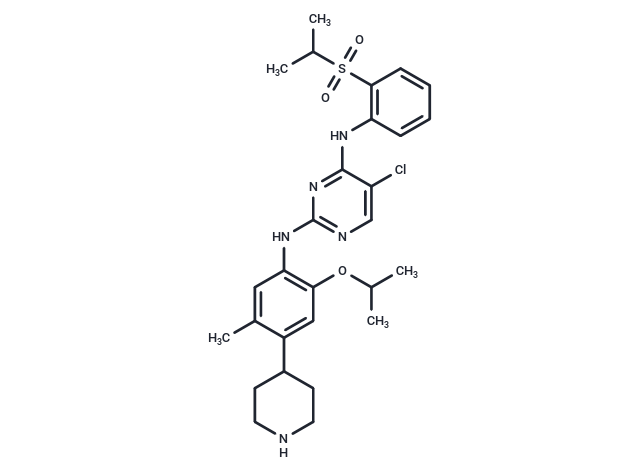Shopping Cart
Remove All Your shopping cart is currently empty
Your shopping cart is currently empty
Ceritinib (LDK378) is an ALK tyrosine kinase inhibitor (IC50=200 pM) with selective, ATP-competitive, and oral activity. Ceritinib also inhibits IGF-1R, InsR, and STK22D (IC50=8/7/23 nM). Ceritinib has antitumor activity.

| Pack Size | Price | USA Warehouse | Global Warehouse | Quantity |
|---|---|---|---|---|
| 5 mg | $45 | In Stock | In Stock | |
| 10 mg | $63 | In Stock | In Stock | |
| 50 mg | $91 | In Stock | In Stock | |
| 100 mg | $136 | In Stock | In Stock | |
| 1 mL x 10 mM (in DMSO) | $55 | In Stock | In Stock |
| Description | Ceritinib (LDK378) is an ALK tyrosine kinase inhibitor (IC50=200 pM) with selective, ATP-competitive, and oral activity. Ceritinib also inhibits IGF-1R, InsR, and STK22D (IC50=8/7/23 nM). Ceritinib has antitumor activity. |
| Targets&IC50 | IGF-1R:8 nM (cell free), STK22D:23 nM (cell free), ALK:0.2 nM (cell free), Insulin receptor:7 nM (cell free) |
| In vitro | METHODS: A panel of tumor cells and multidrug resistant (MDR) cells were treated with Ceritinib (0.01-10 µM) for 72 h. Cell viability was measured by MTT assay. RESULTS: The IC50 values of KB, KBv200, MCF-7, MCF-7/adr, S1, S1-M1-80, HEK293/pcDNA3.1, HEK293/ABCB1 and HEK293/ABCG2-R2 cells were 1.10±0.31, 1.69±0.41, 2.15±0.33, 2.73±0.46, 1.34±0.35, 1.69±0.39, 1.50±0.37, 1.86±0.34, 2.84±0.56 µM. Based on the cytotoxicity profile, more than 85% of the cells survived at 0.5 µM Ceritinib concentration. [1] METHODS: Human breast cancer cell lines MDA-MB 453 and MFM223 were treated with Ceritinib (10 µM) for 15 min-4 h. Target protein expression levels were measured by Western Blot. RESULTS: Ceritinib treatment down-regulated AR, ACK1, HER2, and HER3 in MDA-MB-453 and MFM223 cells in a time-dependent manner. [2] |
| In vivo | METHODS: To assay anti-tumor activity in vivo, Ceritinib (25 mg/kg, administered orally) and paclitaxel (20 mg/kg, administered intraperitoneally) were administered four times every three days to nude mice bearing KBv200 xenografts. RESULTS: No significant differences in tumor size were found between animals treated with saline, Ceritinib or paclitaxel, respectively. However, the combination of Ceritinib and paclitaxel had a significant inhibitory effect on tumor growth compared to the other groups. [1] |
| Kinase Assay | All kinases were expressed as either Histidine- or GST-tagged fusion proteins using the baculovirus expression technology except for the untagged ERK2 which was produced in E. coli. The kinase activity was measured in the LabChip mobility-shift assay. The assay was performed at 30°C for 60 min. The effect of the compound on the enzymatic activity was obtained from the linear progress curves in the absence and presence of compound and routinely determined from one reading (end point measurement) [1]. |
| Cell Research | Luciferase-expressing cells were incubated with serial dilutions of compounds or DMSO for 2–3 days. Luciferase expression was used as a measure of cell proliferation/survival and was evaluated with the Bright-Glo Luciferase Assay System. IC50 values were generated by using XLFit software [1]. |
| Animal Research | SCID beige mice for crizotinib-resistant H2228 xenograft tumor models, nude mice for MGH006 primary explants and MGH045 cells were randomized into groups of 5, 6 or 8 mice with an average tumor volume of ~150 mm^3 and received Crizotinib or ceritinib daily treatments by oral gavage as indicated in each study. Tumor volumes were determined by using caliper measurements and calculated with the formula (Length × Width × Height)/2 [3]. |
| Synonyms | LDK378 |
| Molecular Weight | 558.14 |
| Formula | C28H36ClN5O3S |
| Cas No. | 1032900-25-6 |
| Smiles | N(C1=C(OC(C)C)C=C(C(C)=C1)C2CCNCC2)C=3N=C(NC4=C(S(C(C)C)(=O)=O)C=CC=C4)C(Cl)=CN3 |
| Relative Density. | 1.251 g/cm3 (Predicted) |
| Color | White |
| Appearance | Solid |
| Storage | Powder: -20°C for 3 years | In solvent: -80°C for 1 year | Shipping with blue ice/Shipping at ambient temperature. | ||||||||||||||||||||||||||||||
| Solubility Information | DMSO: 16 mg/mL (28.67 mM), Sonication is recommended. Ethanol: 3 mg/mL (5.37 mM), Sonication is recommended. H2O: < 1 mg/mL (insoluble or slightly soluble) | ||||||||||||||||||||||||||||||
| In Vivo Formulation | 10% DMSO+40% PEG300+5% Tween 80+45% Saline: 0.8 mg/mL (1.43 mM), Solution. Please add the solvents sequentially, clarifying the solution as much as possible before adding the next one. Dissolve by heating and/or sonication if necessary. Working solution is recommended to be prepared and used immediately. The formulation provided above is for reference purposes only. In vivo formulations may vary and should be modified based on specific experimental conditions. | ||||||||||||||||||||||||||||||
Solution Preparation Table | |||||||||||||||||||||||||||||||
Ethanol/DMSO
DMSO
| |||||||||||||||||||||||||||||||
| Size | Quantity | Unit Price | Amount | Operation |
|---|

Copyright © 2015-2025 TargetMol Chemicals Inc. All Rights Reserved.